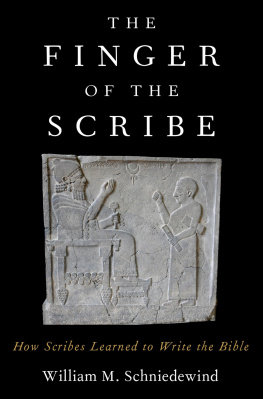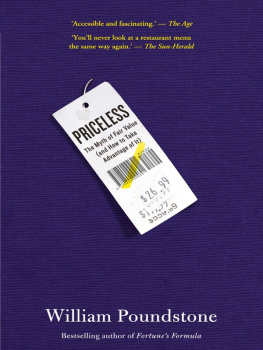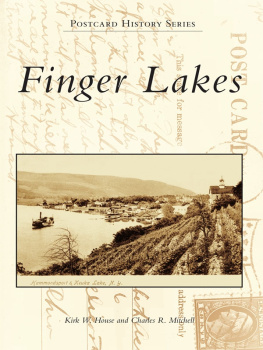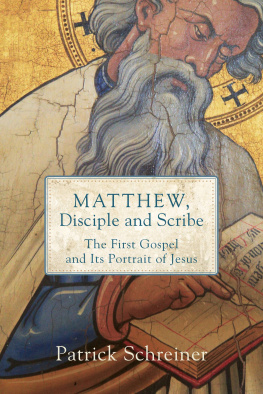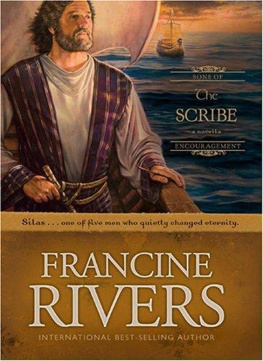William M. Schniedewind - The Finger of the Scribe
Here you can read online William M. Schniedewind - The Finger of the Scribe full text of the book (entire story) in english for free. Download pdf and epub, get meaning, cover and reviews about this ebook. year: 2019, publisher: Oxford University Press, genre: Children. Description of the work, (preface) as well as reviews are available. Best literature library LitArk.com created for fans of good reading and offers a wide selection of genres:
Romance novel
Science fiction
Adventure
Detective
Science
History
Home and family
Prose
Art
Politics
Computer
Non-fiction
Religion
Business
Children
Humor
Choose a favorite category and find really read worthwhile books. Enjoy immersion in the world of imagination, feel the emotions of the characters or learn something new for yourself, make an fascinating discovery.
- Book:The Finger of the Scribe
- Author:
- Publisher:Oxford University Press
- Genre:
- Year:2019
- Rating:3 / 5
- Favourites:Add to favourites
- Your mark:
- 60
- 1
- 2
- 3
- 4
- 5
The Finger of the Scribe: summary, description and annotation
We offer to read an annotation, description, summary or preface (depends on what the author of the book "The Finger of the Scribe" wrote himself). If you haven't found the necessary information about the book — write in the comments, we will try to find it.
The Finger of the Scribe — read online for free the complete book (whole text) full work
Below is the text of the book, divided by pages. System saving the place of the last page read, allows you to conveniently read the book "The Finger of the Scribe" online for free, without having to search again every time where you left off. Put a bookmark, and you can go to the page where you finished reading at any time.
Font size:
Interval:
Bookmark:


Oxford University Press is a department of the University of Oxford. It furthers the Universitys objective of excellence in research, scholarship, and education by publishing worldwide. Oxford is a registered trade mark of Oxford University Press in the UK and certain other countries.
Published in the United States of America by Oxford University Press
198 Madison Avenue, New York, NY 10016, United States of America.
Oxford University Press 2019
All rights reserved. No part of this publication may be reproduced, stored in a retrieval system, or transmitted, in any form or by any means, without the prior permission in writing of Oxford University Press, or as expressly permitted by law, by license, or under terms agreed with the appropriate reproduction rights organization. Inquiries concerning reproduction outside the scope of the above should be sent to the Rights Department, Oxford University Press, at the address above.
You must not circulate this work in any other form and you must impose this same condition on any acquirer.
CIP data is on file at the Library of Congress
ISBN 9780190052461
eISBN 9780190052485
According to the writer of Exodus, God gave Moses two tablets of the covenant, tablets of stone, written by the finger of God. It is a glorious anthropomorphic image of divine inspiration. In contrast, I write about the finger of the scribe, which depended on education. Scribes depended on teachers and curriculum to learn how to write. Throughout the Bible, a variety of figuresscribes, prophets, priests, kings, and even a young boywrite various things, including both mundane and profound texts. The Hebrew Bible contains lists and letters but also liturgies and stories, all written by scribes. This book explores how the early alphabetic scribes began to learn how to write and, eventually, how they learned to write the Bible. In this book, I am particularly interested in scribal educationor, more specifically, scribal curriculum. What were scribes textbooks? What did they practice? What did they memorize? And, how did this shape the Bible? I believe that I found the key to unlocking these questions in the scribal scribbles at Kuntillet Ajrud as well as in the cuneiform school texts used in Canaan at the end of the Late Bronze Age.
The project was many years in the making and was helped along the way by innumerable people. First of all, I want to thank my colleagues and students at UCLA, from whom I believe I learned and received more than I taught and gave. In particular, I wish to acknowledge Aaron Burke, Bob Cargill, Elizabeth Carter, Kara Cooney, Jacco Dieleman, Brian Donnelly-Lewis, Elizabeth VanDyke, Robert Englund, Tim Hogue, Moise Isaac, Alice Mandell, Roger Nam, Jason Price, Rahim Shayegan, Jeremy Smoak, Matt Suriano, Stephen Ward, and Jonathan Winnerman. I have a special appreciation for Elizabeth VanDyke, whose critical eye working as my Graduate Research Assistant improved this book immeasurably. I also received a great deal of support, encouragement, and critique along this journey from a variety of fellow travelers, including Susan Ackerman, Erhard Blum, David Carr, Aaron Demsky, Dan Fleming, Ron Hendel, Jan Joosten, Anat Mendel-Geberovich, Anson Rainey (zl), Gary Rendsburg, Seth Sanders, Joachim Schaper, Mark Smith, Jeff Stackert, Steve Tinney, David Vanderhooft, Jackie Vayntrub, and Ed Wright. I have presented this material to a variety of audiences who have all shaped my thinking in a variety of ways. It began with the invitation by Gabrielle Boccacini to a conference on early Jewish education in Naples. There, I especially benefited from extended conversations with Steve Tinney about Mesopotamian education. I also wish to thank the Near Eastern Studies Department at Johns Hopkins University for the invitation to give the Samuel Iwry Lecture. I also presented parts of this book to the Biblical Colloquium and its members in the seminar organized by David Vanderhooft. Their interaction and comments were particularly stimulating. Finally, I need thank UCLA, which has given me the resources and support for this research. I appreciate the many people and places at UCLA that made this book possible, including Dean of Humanities David Schaberg, the Center for Jewish Studies, the Center for the Study of Religion and its director Carol Bakhos, and finally our Department chair Kara Cooney. Support for this research was also provided by the Reuben and Norma Kershaw Term Chair in Ancient Eastern Mediterranean Studies. Last but not least, I thank my familymy wife, Jeanne, and my daughters, Tori and Mikaelaand, a special shout-out for Tori, who discussed many things Egyptological with me and spurred my decipherment of the Lachish jar inscription. Nothing was here accomplished alone, but I take credit for all its shortcomings.
| ABD | Anchor Bible Dictionary |
| AOAT | Alter Orient und Altes Testament |
| BA | Biblical Archaeologist |
| BAR | Biblical Archaeology Review |
| BASOR | Bulletin of the American Schools of Oriental Research |
| BZAW | Beihefte zur Zeitschrift fr die alttestamentliche Wissenschaft |
| COS | K. Lawson Younger and William W. Hallo, eds., The Context of Scripture, 3 volumes (Leiden: Brill, 2003). |
| EA | El-Amarna letters. See Anson F. Rainey, The El-Amarna Correspondence: A New Edition of the Cuneiform Letters from the Site of El-Amarna Based on Collations of All Extant Tablets, ed. William Schniedewind, vol. 1 (HdO 110; Leiden: Brill, 2015). |
| GKC | Gensenius-Kautzsch-Cowley, Gensenius Hebrew Grammar, Wilhelm Gesenius, Emil Kautzsch, and Arthur Ernest Cowley (Oxford: Clarendon, 1910). |
| HALOT | Hebrew and Aramaic Lexicon of the Old Testament, Ludwig Kohler and Walter Baumgartner, 4 volumes (Leiden: Brill, 19942000). |
| HS | Hebrew Studies |
| HUCA | Hebrew Union College Annual |
| IEJ | Israel Exploration Journal |
| JANES | Journal of Ancient Near Eastern History |
| JAOS | Journal of the American Oriental Society |
| JBL | Journal of Biblical Literature |
| JEA | Journal of Egyptian Archaeology |
| JNES | Journal of Near Eastern Studies |
| JQR | Jewish Quarterly Review |
| JSOT | Journal for the Study of the Old Testament |
| JSOTSS | Journal for the Study of the Old Testament Supplement Series |
| JSS | Journal of Semitic Studies |
| KAI | Kanaanische und Aramische Inschriften (2nd edition), Herbert Donner and Wolfgang Rllig (Wiesbaden: Harrassowitz, 2002). |
| KTU | Dietrich Manfried, Oswald Loretz, and Joaqun Sanmartn, eds., The Cuneiform Alphabetic Texts from Ugarit, Ras Ibn Hani and Other Places: From Ugarit, Ras Ibn Hani and Other Places (Mnster: Ugarit-Verlag, 1995). |
| NEA |
Font size:
Interval:
Bookmark:
Similar books «The Finger of the Scribe»
Look at similar books to The Finger of the Scribe. We have selected literature similar in name and meaning in the hope of providing readers with more options to find new, interesting, not yet read works.
Discussion, reviews of the book The Finger of the Scribe and just readers' own opinions. Leave your comments, write what you think about the work, its meaning or the main characters. Specify what exactly you liked and what you didn't like, and why you think so.

